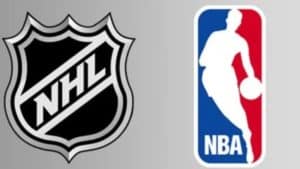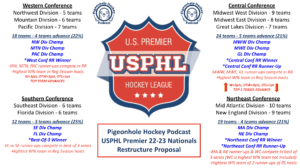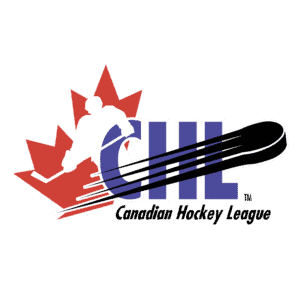Advancement to NCAA Collegiate Hockey
We’ve all become accustomed to Junior and youth leagues citing the number of “advancements” to which they lay claim. Advancements are players who have played for a particular organization and “advanced” to a higher level of play.
A youth club can cite advancement to Junior hockey, Prep hockey, college hockey, and professional hockey. Junior teams and leagues lay claim to college and professional advancement. The higher up the ladder you go, there are obviously fewer levels to which you can lay claim regarding advancement.
The data gets clouded with players who play for multiple organizations on their way to college.
For example, if Johnny Lightning plays 16U for one organization, 18U for another organization, Tier III Juniors for two teams because of mid-season trade, then to the USHL for a cup of coffee, then North American Hockey League for a year, then matriculates to a college hockey roster … all six teams and all leagues will lay claim to his advancement to college.
It’s perfectly legitimate as far as straight facts are concerned as there is no way to attribute Johnny Lightning’s college matriculation to just one of those five organizations. They all played a role. And yes – we realize there are infrequent situations where a player suits up for one or two games for an organization and that organization claims a role in his advancement, but those are so few and far between they don’t make a dent in four-years of compiled data.
Because of the numerous claiming organizations, the only straight data that can be tracked is the direct-to-college movement, meaning the organization/league for which the player last participated. This is especially pertinent to NCAA Division II and III advancement since those players do not verbally commit two or three years in advance. As a general rule, the vast majority of NCAA Division II and III players make their commitment the season prior to enrolling in college, which is why the direct-to-college data is so important.
NCAA D1 Commitments happen at younger ages
At the NCAA Division I level the commitments are more commonly made when players are younger. For the past few years players as young as 13 or 14 were making verbal commitments. While much of the hockey public shook its head at the impracticality of that practice, which meant a player could conceivably make a commitment up to seven years before matriculation to school, it was still acknowledged because there was legitimacy to the process.
The new NCAA rules regarding player contact will tighten up the commitment data, as it shortens the time between commitment and matriculation, which in turn provides less time for “de-commitments” to take place.
For now, it’s still more reliable to research and record the direct-to-college data at the Division I level also. In the future, TJHP will be able to compile solid data that reflects where a player was playing when he committed to NCAA Division I, but for now, that wouldn’t be very solid data.
Moving along to the actual data portion of today’s meal, NCAA Division I is fairly cut-and-dried when it comes to direct-to-college matriculation. Cut-and-dried translates to “dominated by the United States Hockey League (USHL)” which includes the players from USA Hockey’s National Team Development Program (USNTDP).
The Data…
Keep in mind this data is not limited to freshmen, as is the NCAA Division II and III data below. This is data for all NCAA Division I rostered players for 2019-20 – freshmen through seniors — freshly supplied by College Hockey Inc.:
- USHL (includes 50 players from USNTD))…………………….686
- North American Hockey League (NAHL)……………………… 301
- British Columbia Hockey League (BCHL)………………………272
- Alberta Junior Hockey League (AJHL)………………………….. 99
- Ontario Junior Hockey League (OJHL)…………………………..82
- United States Premier Hockey League (USPHL)/NCDC…..75
- Central Canada Hockey League (CCHL)………………………..57
- Prep/High Schools (HS)……………………………………………….31
There isn’t a lot of recap or analytics that go into the NCAA Division I matriculation data because many of these players are already committed by the time they reach their Junior organizations. The path is pretty clear as players march toward Division I regardless of where they are playing when they commit.
Plenty of Diversity on the path to NCAA Hockey
As you can see, there isn’t a lot of diversity as a Division I player travels his path to college.
In 2014 when I was serving as executive director of the Eastern Hockey League I created the first set of data for NCAA Division II and III advancement. At the time the EHL ownership room was looking at its three or four Division I players each season and trying to figure out how to get more.
My thoughts were to re-organize the “product” and focus on what it was the EHL did best – move players to NCAA Division II and III. However, there seemed to be no data other than simple website claims of player advancement made each season, many of whom never actually enrolled in that college or actually attempted to play hockey.
Everyone was claiming advancements the same way, but the actual data was never compiled in a trackable format. I copy-pasted every 2015-16 NCAA freshman into a spreadsheet and tracked from which source they matriculated, and have done the same every year since. Obviously, I was contracted to the EHL in 2014 and then the USPHL in 2016-17, but the data is now (and always was) independent and verifiable.
During the past four years, it’s become pretty clear how to best get to NCAA Division II or III, but as indicated below there is an extremely diverse number of options. This data isn’t as clean as the Division I data because it is by the league (same as Division I), but the USPHL/NCDC, NAHL, and EHL each have more than one “league” under their umbrella. When compiling data under the umbrella the EHL still leads the way with 556, followed by the USPHL/NCDC with 541 and NAHL/NA3HL with 508.
You’re not likely to hear or read the NAHL or NCDC pumping their Division II/III placement tires, but again – the data is irrefutable if you are looking for a Division II/III roster spot.
Another way to look at the data
Is to consider the Placement Per Team ratio, which moves the EHL way back into the lead in this category. Because of fluctuation in the number of teams it’s difficult to give a verifiable per-team advancement number, but consider for 2019-20 the EHL has 32 teams (19 EHL and 13 EHLP), the NAHL/NA3HL has 60 teams (26 NAHL and 34 NA3HL) and the USPH/NCDC has 82 teams (52 Premier, 17 Elite, 13 NCDC).
Using those numbers as a pretty solid estimate you’re looking at EHL with 4.34 per team, NAHL/NA3HL with 2.11 per team, and USPHL/NCDC with 1.65 per team. An even deeper reality is the EHL’s top division averages about 7 advancements per team per season, which creates an even bigger divide on a per-team basis.
A final data point
Since the EHL’s tires are being pumped a little in regard to this overview: The EHL’s “winning margin” has decreased each year from 16 percentage points in 2015 to seven, then six and finally two points last year.
Stay tuned later in the year for the 2019-20 NCAA Division II/III advancement data and corresponding breakdown. Below is the cumulative data from 2015-16 through the 2018-19 seasons.












